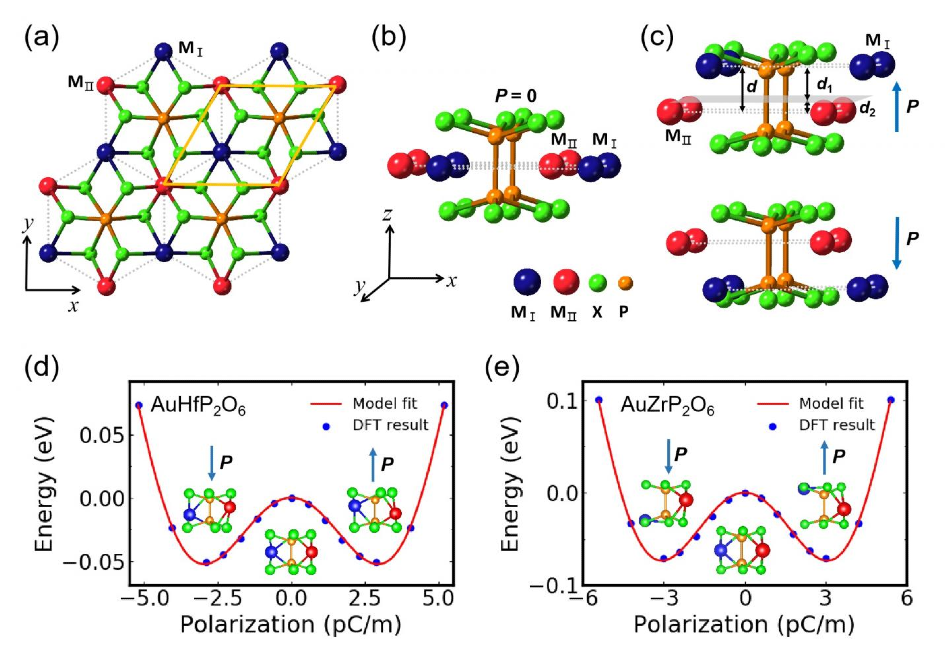Sep 29 2020
Ferroelectricity is often believed to appear in semiconducting or insulating materials instead of in metals. This is because, in the case of metals, conducting electrons invariably screen out the internal static electric field that emerges from the dipole moments.
 Schematic structures of 2D bimetal phosphates (MIMIIP2X6, MI, and MII atoms are different metal elements, X=O, S, Se, Te). (a) Top view. (b) Side view of the paraelectric phase. (c) Side view of ferroelectric phases with opposite polarization (P). (d)(e) Energy versus polarization of two ferroelectric metals (AuHfP2O6 and AuZrP2O6), showing the possible ferroelectric-paraelectric transition. ©Science China Press.
Schematic structures of 2D bimetal phosphates (MIMIIP2X6, MI, and MII atoms are different metal elements, X=O, S, Se, Te). (a) Top view. (b) Side view of the paraelectric phase. (c) Side view of ferroelectric phases with opposite polarization (P). (d)(e) Energy versus polarization of two ferroelectric metals (AuHfP2O6 and AuZrP2O6), showing the possible ferroelectric-paraelectric transition. ©Science China Press.
Earlier in 1965, Anderson and Blount had suggested the theory of “ferroelectric metal,” indicating that the electric polarization may appear in specific martensitic transitions because of the inversion symmetry breaking [Anderson et al. Physical Review Letters 1965, 14, 217-219].
But after examining for more than 50 years, very rare ferroelectric metals have been reported, to date. However, in 2018, two to three WTe2 layers were reported to have switchable spontaneous out-of-plane polarization. This could be the first experimental observation for the coexistence of metallicity and ferroelectricity in a 2D material [Fei et al. Nature 560, 336 (2018)].
Gang Su and coworkers have methodically analyzed a large series (2,964) of 2D bimetal phosphates. This was done by using data-driven machine learning along with high-throughput first-principles calculations and novel electronic orbital based descriptors, and the team successfully identified 60 stable 2D ferroelectric materials that have out-of-plane polarization containing 16 new ferroelectric metals as well as 44 ferroelectric semiconductors, inclusive of seven multiferroics.
These multiferroics show the coexistence of two or three kinds of ferroic orderings, such as ferroelastic, ferroelectric, ferromagnetic, and antiferromagnetic orderings, and seven ferroelectrics that are appropriate for water-splitting photocatalysts. Such multiferroic materials may have promising applications in magnetostrictive, magnetoelectric, or mechanic-electric nanodevices.
By doing an in-depth charge analysis, the researchers observed that the conducting electrons predominantly move on an upper surface of such 2D ferroelectric metals, while the electric polarization, which is vertical to the upper surface, is from the lower surface, which arises from the spontaneous inversion symmetry breaking caused by opposite displacements of bimetal atoms, and thus gives rise to the coexistence of ferroelectricity and metallicity.
The researchers also found that the full-d-orbital coinage metal elements are responsible for causing the displacements and polarization that are larger than other types of elements.
They also investigated the ferroelectric-paraelectric phase transition as well as polarization reversal in the 2D ferroelectric metals, which showed that common double-well shape and clear bistability are exhibited by the energy versus polarization profiles. In this shape and bistability, the maximum corresponds to the paraelectric phase, and the two minima correspond to the ferroelectric phases of opposite polarizations.
Furthermore, Van der Waals heterostructures built on such ferroelectric metals were also demonstrated in potential applications to modify the Schottky-Ohmic contact type or the Schottky barrier height, denoting that they could be used to exploit the vertical transport characteristics of the devices.
The latest research considerably expands the series of 2D ferroelectric metals, which would trigger more interest in the additional exploration of 2D ferroelectric metals both in experiments and theories. It also presents an efficient way by integrating data-driven machine learning as well as high-throughput first-principle calculations to speed up discoveries of novel and next-generation functional materials.
The study is funded by the National Key R&D Program of China, the Strategic Priority Research Program of CAS, the National Nature Science Foundation of China, and the Beijing Municipal Science and Technology Commission.
The calculations were carried out on Era at the Supercomputing Center of Chinese Academy of Sciences and Tianhe-2 at the National Supercomputing Center in Guangzhou.
Journal Reference:
Ma, X-Y., et al. (2020) Large family of two-dimensional ferroelectric metals discovered via machine learning. Science Bulletin. doi.org/10.1016/j.scib.2020.09.010.